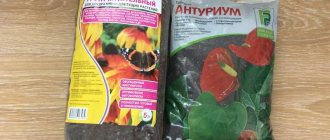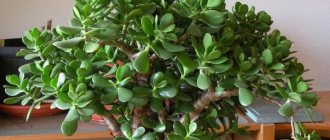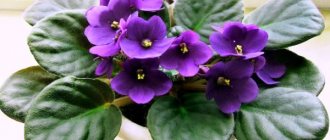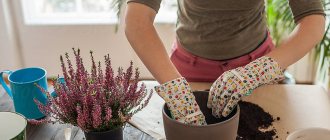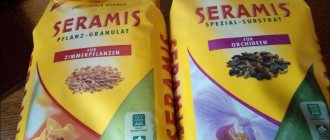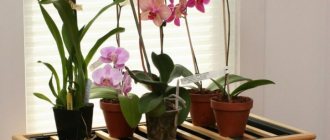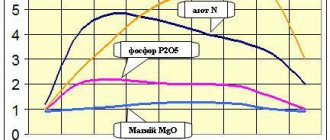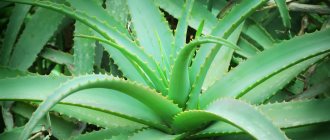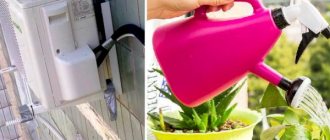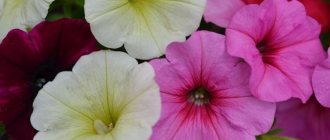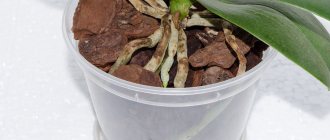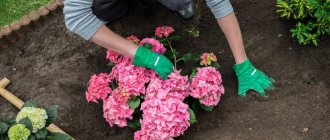Phalaenopsis are predominantly epiphytic orchids that prefer to live in trees rather than on the ground. This feature requires an extremely careful approach to the choice of substrate. It is necessary to understand that even a minor mistake made during the manufacturing process can lead to the most dire consequences.
In the article we will tell you in detail what kind of soil is needed for the phalaenopsis orchid for its healthy development. You will also learn how to choose the right soil mixture in the store or make it yourself using our step-by-step instructions and videos.
The importance of an unmistakably composed substrate: can it be planted in the ground?
The soil for the flower in question serves, first of all, as a support. For this reason, it is subject to special requirements regarding looseness, moisture absorption and breathability.
Phalaenopsis is unlikely to live long in ordinary soil. First of all, its roots, which take an active part in photosynthesis, will rot. Following this, the upper part of the plant will begin to fade. Accordingly, phalaenopsis will definitely not be able to bloom in the wrong substrate.
The nuance is that the root system needs light no less than the leaves. Ordinary land cannot provide this.
Look at any photo of an orchid growing at home in a transparent pot, and you will understand why a regular soil mixture will not work for it.
Review of ready-made
As a rule, all beginners repeat the same mistake, believing that an orchid will take root in any soil. One of the reasons why flowers should not be placed in the ground is considered to be the toxins and metals that make up its composition. The soil in the garden, no matter how clean it is, is a habitat for various bacteria and microorganisms that can harm vulnerable household residents.
If you are choosing orchids to grow at home, be prepared to buy soil. Substrate for flowers is not cheap, but these costs are completely justified. By purchasing the ready-made mixture, you receive:
- clear concentration of nutrients;
- chemical composition that meets the requirements of plants;
- suitable microflora;
- complete control over moisture and air;
- sterility;
- saving time and effort on care.
Many substrates are universal. They are suitable for all indoor plants. Orchids need special conditions. So, the soils that we will discuss below are considered the leaders for them.
Seramis
This complex was developed by German scientists. It contains clay, fertilizers, and a moisture indicator. Thanks to precisely selected components, it is used for planting flowers in places where it is difficult to keep track of a large number of plants. Seramis is used in hotel complexes, gyms, offices and administrative buildings. In Europe, this complex has been widespread for a long time, but in the CIS it is just beginning to conquer its consumers.
Clay granulate is suitable for a long time. The service life lasts for decades. It does not need to be replaced, diluted or fertilized. "Ceramis" is not prone to compaction and retains a loose structure, regardless of the amount of water and conditions of detention.
The technology of action is that the granules are saturated with water and transfer liquid filled with useful substances to the flower when it is needed. This maintains balance, which is extremely important for orchids. In addition, the high degree of absorbency allows you to choose interesting interior solutions, pots with a unique design without pallets.
Bio effect
The Bio Effect substrate for orchids is one of the most common. It contains exclusively organic components. The main one in most cases is the bark of the Angara pine, which allows the substrate to be used for plants with high requirements for air permeability. The raw materials are pre-processed and dried in special equipment. Adding dolomite normalizes the acid balance of the soil. The microorganisms that make up the Bio Effect increase the survival rate of plants and their immunity.
Ambulance
Practice shows that this substrate is not suitable for all plants. The reason lies in the composition of sawdust and peat. There is very little bark in the complex, so after moisture enters the soil turns into an incomprehensible substance. Excess liquid leads to activation of the process of root rotting. If you decide to choose this substrate, then carefully monitor watering.
Royal Mix
The mixture is based on calibrated bark, pre-treated by thermal means. Coconut fiber, charcoal and coarse peat are added to it. The raw materials are rich in magnesium, zinc and iron. Thanks to the properties of the components, the plant’s microclimate will be fine. The loose structure prevents waterlogging, and the thermal insulation maintains a stable temperature. Coal prevents diseases and fungi from developing.
What soil composition is needed for a phalaenopsis orchid?
It must be emphasized that phalaenopsis cannot be planted in a substrate where there is soil. If you come across such a mixture in a store, then draw the right conclusions and do not purchase any more products from this brand.
The situation, however, is quite possible to improve. Simply pour the contents of the bag into a bucket of water and use only the ingredients that float to the top.
The soil intended for phalaenopsis varies in composition. However, the main ingredient is almost always pine bark. Strictly speaking, it is not an ideal solution, but it is excellent for growing representatives of the Orchid family at home. The material, on the one hand, ensures uniform distribution of water, and on the other, allows air to penetrate to the roots.
If you collected the bark yourself, be sure to sterilize it by boiling. This will kill pests, bacteria and reduce resin content. It is important to get rid of the latter, as it greatly reduces moisture capacity.
Oak bark is used a little less frequently. Its properties fully correspond to those of pine. But tannins can create a problem here. They can also be removed by boiling.
Peat is taken from the top. Its advantage is high moisture capacity. The component adsorbs nutrients and gradually releases them to the orchid. The disadvantage of the material is high acidity. The indicator is normalized by mixing dolomite flour (1 tbsp per kg).
Coconut fiber is used as a substitute for peat and sphagnum moss. It does not cake, absorbs water well, and does not interfere with air circulation. It is mainly taken when phalaenopsis is planted in blocks.
Vermiculite loosens the soil mixture and slows it down:
- drying out;
- compaction;
- salinization
Sphagnum moss is uniquely hygroscopic. It is able to absorb moisture even from the air, which is very valuable for phalaenopsis. It is also a supplier of a number of useful minerals.
Charcoal is mixed into substrates in limited quantities (no more than 5%). Its purpose is to enhance air permeability and moisture capacity. There is another advantage - antiseptic properties.
Pine cones are sometimes recommended for use as a substrate, but this should only be done in extreme cases. The problem is that they contain a lot of resin, which cannot be removed by boiling.
Important: humus or leaf soil can be placed in the soil for phalaenopsis, but in very small quantities. They must be steamed first.
To grow a healthy orchid, you will also need drainage. Most often used:
- expanded clay;
- Styrofoam;
- small crushed stone;
- broken ceramics.
These components are placed strictly on the bottom of the pot, but sometimes some of them are included in the substrate.
In Europe, several thousand pioneer orchids were “killed” by overly intensive and improper care. Flower growers, not accustomed to epiphytes, tried to grow the flower in ordinary soil. Alas, today many green beauties are dying for the same reason. What do you need to know about orchids and what substrate to prefer?
Lifestyle
The main goal is to recreate the most natural conditions. What are epiphytes? These are plants that live on other plants. They are not parasites. The orchid obtains nutrients from decay products, water and a thin layer of soil on the bark of trees. When it rains, dust flows from the leaves and branches directly to the green beauty. Protruding aerial roots trap moisture particles.
A dense soil mixture is tantamount to murder for an orchid. In nature, its roots remain exposed. They breathe and easily get rid of excess fluid. The last factor is especially destructive: with an increased level of humidity, the flower begins to rot. How to properly provide the green beauty with nutrients and water?
Substrate components
The question of choosing a mixture is purely individual. The requirements depend on the level of humidity in the room, the condition of the plant, the species characteristics... However, the rules are general: the soil must be well breathable and not create a “swamp” in the pot. What might you need?
Bark.
Oak, birch, spruce are suitable, but pine . This is the main "ingredient". The bark of the middle fraction (1.5-3 cm) provides air circulation and maintains optimal humidity, but is not very nutritious. Its task is to give the mixture a light structure. The pieces decompose relatively quickly, “pulling” nitrogen from the roots. When feeding, take this nuance into account.
Pine bark acidifies the soil. For us this is a positive quality. First, a low pH reduces the risk of rotting after replanting. Harmful bacteria multiply less easily and cannot infect wounded roots. Secondly, when watering with tap water, alkalization and accumulation of salts occur. The wood component slows down this process. If the imbalance is critical, add a little dolomite flour.
It is not difficult to buy pine bark: it is inexpensive and is available in almost every flower shop. Some people prefer to collect the material themselves. It is important to know that insect-damaged, living or long-dead bark (for example, from old stumps) is not suitable. It is advisable to take “flaking” or from recently fallen trees, at the foot. It has less resin. Insect larvae and sticky residues can be removed by heat treatment.
It is advisable to purchase rounded pine bark, if possible; when transplanting into such a substrate, there is less likelihood of damage to the orchid’s root system and the substrate’s breathability is better. There are not many options on the Russian market of substrates and soils for orchids, but there is one worthy substrate that deserves attention: “EffectBio”. It contains less resins, takes longer to decompose, is equipped with beneficial microorganisms and has a stable pH. You can buy EffectBio substrate from the manufacturer in our online store wholesale and retail at a good price.
Coconut chips.
Coconut chips are a more moisture-intensive substrate, but a stable material. Coconut also adds a spongy texture. There is successful experience of growing on pure chips, but it is better to dilute the base with them. Flower growers sometimes lay a layer of coconut on top instead of moss. This is necessary to retain moisture. The key advantage of chips over moss is that they become saturated with salts more slowly.
Sphagnum moss.
Nutritional component. It is the most popular due to its favorable price-quality ratio. It absorbs moisture well, so watering will have to be done a little less often. If you cover the substrate with moss, the liquid will flow into the roots better and more evenly. Just don't overdo it. Unfortunately, the material quickly becomes salty. It needs to be changed every six months.
You can collect moss yourself. It is better to do this in the fall, when there are fewer pests. It is not advisable to freeze fresh product: it will turn into a slimy mass. Buying good quality sphagnum moss is not so easy, it is best to buy from trusted suppliers!
Peat.
Peat is an airy and water-hungry (!) ingredient. More often used when preparing mixtures for adult plants. Peat has low acidity. Add dolomite flour if necessary. You should take about 5 g for every liter of soil. Mix in advance, at least a day before use.
Coal.
Disinfects and absorbs salts. Pieces no larger than 2 cm are suitable. Do not add too much coal, 7% of the total weight is enough. After salting, it has an extremely negative effect on the acid-base balance.
Sand, vermiculite and agroperlite.
Improves structure and imparts looseness. Due to the additives, other components cake less. The sand must be coarse (1-2 mm), quartz or river sand is suitable. Gradually, due to the weight, he himself sinks to the bottom. Agroperlite prevents temperature changes, which is very important for an orchid.
Expanded clay.
Expanded clay acts as drainage. Enjoys a controversial reputation. Many people believe that expanded clay is harmful to plants. Roughly speaking, this is ordinary clay fired in a kiln. There's nothing wrong with it. Crushed stone is durable and allows water to pass through well, but absorbs salts. If you have to frequently feed the plant, then expanded clay will soon become a chemical “bomb”. Such granules need to be changed, otherwise they will lead to burns of the roots. The main disadvantage is the rough surface. The roots of the flower are firmly attached to the rubble at the first opportunity.
Styrofoam.
Excellent analogue. Chemically neutral. Small granules can be used as a loosening agent. Polystyrene foam keeps the temperature at a constant level, preventing you from freezing in winter.
Foam glass.
Foam glass is a new, but very quickly gaining momentum, neutral substrate for growing hydroponics and indoor plants. Foam glass “NANO Drainage and Substrate” is very widely used when transplanting and growing orchids of all varieties and types as drainage and partially as a substrate mixed with pine bark, preferably produced by EffectBio or UltraEffect!
Let us summarize what has been said and written.
- There is no universal mixture.
- Each flower has its own “character”.
- Moss or coconut chips should be added to the “dry” substrate.
- Terrestrial species are tolerant of peat, while others can become waterlogged.
You will have to look for an individual approach and check how he feels. For example, if you notice that the environment has become too wet, increase the amount of charcoal and bark.
Orchid is an omnivorous recycler
The best food for orchids is what we often throw in the trash. Has your plant died? Put it to work: add leaves and roots to the substrate. A “washcloth” made from the dead roots of a tree will perfectly replace coconut fiber. It will improve air flow and provide support. The most valuable “food” is ferns. An orchid will not refuse nut shells, cereal husks, and even its own dry roots.
Another available source of food is fallen leaves. They rot slowly and transfer nutrients. Oak is considered a favorite. The ideal option is beech. Its leaves provide conditions for the development of its own antibacterial microflora.
Always try to take some old soil. Over time, the plant has created its own environment; it lives in symbiosis with fungi. It is advisable to maintain a strong connection.
Ready-made mixtures for growing orchids
When drawing up, you need to start from the specific type and conditions, but there are basic options. For example, the simplest without taking into account the features is pine bark, sphagnum, charcoal and fallen leaves (10: 4: 1: 1). Large pieces of bark will replace drainage.
Some “picky people” need increased air circulation. If you notice that the roots are suffocating, add foam balls, as well as coconut fiber or fern roots.
Terrestrial species require richer soil. Organic fertilizers and peat are added to it. Stock up on peach, apple or beech leaves, dry mullein, moss and fern. These flowers are the most demanding, they need a complete set.
Orchids, contrary to popular belief, are not at all capricious. They do not require frequent watering and intensive care. You need to understand the green beauty, feel it, “make friends” with her, and then she will delight you with bright flowers.
Ladies and Gentlemen! If you liked the article or have comments, write to us, we will be happy to read and take into account your experience and opinion. Thank you for your attention! Sincerely, administration of the site EffectBio.RF
Store soil
The easiest way to provide acceptable conditions for orchids is to use store-bought soil mixtures. Let's tell you more about them.
What should be included
Ready-made substrates typically contain the following ingredients:
- pine bark;
- wood chips;
- charcoal lumps;
- peat;
- sphagnum moss.
Soil for phalaenopsis must be sterilized and packaged in plastic bags or buckets with a capacity of 1 to 5 liters.
Definition of quality
A good composition contains mainly bark - its fraction is small, from 10 to 30 mm. The pieces should remain strong. If they fall apart in your hands, then this is considered a marriage.
Charcoal is taken of medium size (up to 20 mm). He should also be hard and unbreakable.
Moss is used exclusively dry - it is present in the form of small shreds.
A substrate of proper quality is generally crumbly, does not form a lump when compressed, and never contains inclusions with traces of mold.
The smell of dampness is also unacceptable - if there is one, then planting an orchid in such soil is simply dangerous.
How to choose
Not all store-bought mixtures will allow you to grow healthy phalaenopsis, so be very responsible when purchasing them.
First of all, make sure that the soil is intended specifically for orchids - this is indicated by a special mark.
Next, read the list of ingredients - it is advisable that it coincides as much as possible with the above.
Check the container for leaks. The substrate is sterilized, and therefore even a small hole in the packaging can lead to infection by bacteria and pests.
The presence of fertilizers in the mixture is not mandatory. The mineral-enriched option is more suitable for young plants.
Important: if polystyrene foam is included in the substrate, there is nothing wrong with that, but its presence does not eliminate the need to put a drainage layer in the pot.
Choosing the best: purchased options
When deciding which soil is best to buy for a phalaenopsis orchid, many experience difficulties. This is not surprising, because the assortment in stores is very large. However, there are several well-established manufacturers that you can give preference to.
“Garden of Miracles” is a purely Russian finished product, produced for many years by Fart. It is versatile and suitable for many types of orchids, including phalaenopsis. The soil is sold in 2.5 liter bags. For one unit you will have to pay only 95 rubles.
“Flower happiness”, in principle, is ideal for indoor epiphytes, but has one drawback - the substrate contains larch bark. You will have to add pine yourself - this is a direct recommendation from the manufacturer. The price of the mixture, however, is low - just over 70 rubles for 2.5 liters.
Judging by the reviews, the soil called Peter Peat is very good. It is highly nutritious and allows you to confidently grow most epiphytic orchids. The ingredients included in it ensure proper breathability and moisture retention. The optimal choice for transplantation. It is very inexpensive - 50 rubles for 2.5 liters.
Pokon (“Pokon”) is another high-quality ready-made substrate. On the one hand, it does not allow water to stagnate, and on the other, it does not block air access to the orchid’s root system. The manufacturer himself emphasizes that his product contains only natural ingredients:
- top quality bark;
- lime;
- complex feeding.
The volume of the latter is sufficient so that the plant does not need additional fertilizer over the next 2 months. The only disadvantage of soil should be considered its high price. For 2.5 liters you will need to pay approximately 650 rubles.
Compo Sana (“Compo Sana”) is another very expensive German substrate. The soil mainly contains high-moor peat and bark. Auxiliary ingredients are as follows:
- lime;
- minerals.
Many users find that this mixture cannot be considered ready for use due to its high peat content. It is recommended to mix it with homemade soil in a ratio of 1 to 3. The price of 5 liters is approximately 380 rubles.
Probably the best choice in our country is Effect Bio. This substrate ideally combines reasonable price and high quality. The finished mixture is clean and dry.
In addition to Angora pine bark, it contains:
- sphagnum;
- vermicompost.
The environmental friendliness of the soil is confirmed by a certificate of conformity, and therefore it is suitable for most epiphytic orchids. The substrate is suitable for transplanting, growing young orchids and even children. A 2-liter bag will cost 300 rubles.
This, of course, is not a complete review, and therefore, if you come across an unfamiliar brand of soil for phalaenopsis, be sure to read the reviews about it.
In what homemade soil can you plant an orchid at home?
By preparing a mixture for phalaenopsis with your own hands, you can save a lot. The process as a whole is not very labor intensive, but the problem usually arises with finding ingredients.
Advice: choose the right fraction of materials. The older the orchid, the thicker its roots, which means it needs larger pieces, and vice versa.
Standard composition
Homemade substrate contains basically the same ingredients as store-bought substrate. So, it may include:
- bark (pine, oak or spruce);
- sphagnum;
- charcoal (natural, not briquettes);
- high peat;
- fern roots.
All components must be prepared in advance and stored separately. Mix them immediately before planting phalaenopsis.
Comparison with purchased
It is difficult to say with absolute certainty which soil is better - store-bought or home-made.
In the first case, the necessary materials are usually present in average proportions. All of them undergo sterilization. However, such mixtures do not take into account the individual conditions existing in a particular apartment. This means that they will have to be improved on their own.
Self-prepared soil is often cheaper, and sometimes, if you can collect the components yourself, it’s completely free.
However, it is industrially created substrates that inexperienced phalaenopsis collectors should choose. This approach is safer than trying to make soil without proper experience.
Advantages and disadvantages
Homemade substrate is usually of higher quality, provided that the raw materials have been carefully selected and sterilized.
By preparing the soil, you can choose the optimal proportion of components that meets the humidity of your home and the requirements of the phalaenopsis variety being grown.
On the other hand, not all components of the soil for orchids can be found in our country outside the store. Thus, you still have to buy some things.
Where to get components
The most labor-intensive process is collecting the bark. But if there is a sawmill in your city, then go there. Typically, the ingredient in question is sent to waste at such a facility, and therefore may be given away for nothing.
It’s possible to get bark from the forest. It is better not to strip it from a living tree - look for fallen trunks. With the latter it can be removed quite easily.
Peat is easier to buy - its price is low, and the quality is quite acceptable.
Sphagnum moss in our latitudes mainly grows in swamps or damp lowlands. It is permissible to collect it at any time of the year. For our purposes, only living top branches are suitable. Cut them carefully with a knife. The best moss is found near trees.
The collected raw materials must be sorted out - throw away all specks, pine needles, and browned fragments. Dry the rest in a dark place, hanging in bunches. In the future, store in plastic bags.
Tip: the fact that the sphagnum is ready is indicated by its strong discoloration.
Look for humus or deciduous soil in the country house or in the forest. It is better to collect them in the spring, after the snow has melted.
